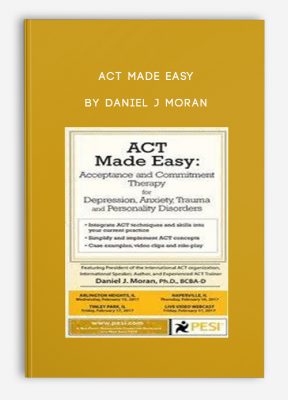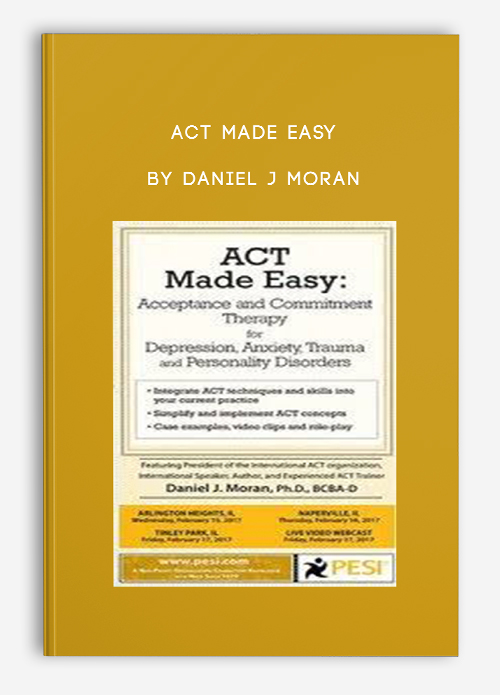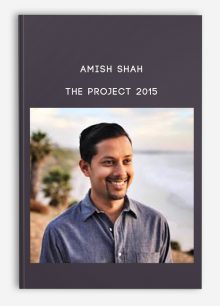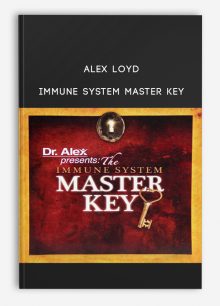ACT Made Easy: Acceptance and Commitment Therapy for Depression, Anxiety, Trauma and Personality Disorders by Daniel J Moran
$219.99 $62.00

ACT Made Easy: Acceptance and Commitment Therapy for Depression, Anxiety, Trauma and Personality Disorders by Daniel J Moran
**More information:
Get ACT Made Easy: Acceptance and Commitment Therapy for Depression, Anxiety, Trauma and Personality Disorders at Salaedu.com
Description
- Integrate ACT techniques and skills into your current practice
- Simplify and implement ACT concepts
- Case examples, video clips and role-play
Integrating Acceptance and Commitment Therapy into your practice offers a new way for you to achieve positive therapeutic outcomes with difficult-to-treat clients.
Join experienced ACT presenter Daniel J. Moran, Ph.D., BCBA-D, as he delivers an exercise and technique-heavy course that will give you the tools needed to more effectively treat clients with depression, anxiety, trauma, and the personality disorders.
Dr. Moran will teach you the main concepts of ACT, including mindfulness, acceptance, and defusion–demonstrating how these create greater psychological flexibility. Discover a variety of techniques for helping clients who are struggling to make difficult behavior changes due to the presence of painful thoughts, feelings and memories. You will learn how to effectively use metaphors, custom techniques and experiential exercises to help your clients identify their values and translate them into behavior goals.
Through case examples, video clips, and role-play you will be able to integrate ACT techniques and skills in your practice tomorrow!
ACT in a Nutshell
- The role of values: mindfulness, acceptance, commitment, behavior
- Experiential avoidance
- Existential behaviorism
- Psychological flexibility
- ACT for anxiety, depression, trauma and personality disorders
- Disorder-specific strategies
- Common treatment elements
- Metaphors, paradox and experiential exercises
Role of Exposure in ACT
- Translate client values into behavioral goals
- Barriers to behavioral goals: external and internal avoidance
- External Exposure
- Situations
- People
- Internal Exposure
- Thoughts
- Emotions
- Memories
- Bodily sensations
ACT in Action
- Anxiety
- Client avoidance strategies (including rumination)
- Clean vs. dirty anxiety
- Attack reason giving
- Anxiety detector exercise
- Turn up the willingness knob
- Mountain of food metaphor
- Passengers on the bus metaphor
- And vs. but
- Trauma
- Function of trauma symptoms
- Specify treatment goals
- Target self-harm behaviors
- Increase psychological safety
- Tin can monster exercise
- Mindfulness exercises
- Depression
- Role of avoidance in depression
- Target suicidality
- Evaluation vs. description exercise
- Buy thoughts and defuse language
- Observing self-exercise
- Personality Disorders
- Increase emotional tolerance
- Values clarification
- Mind vs. experience
- Man in the Hole analogy
- Target the client’s story
- Work with client anger
- Role of therapist self-disclosure
- Chessboard metaphor
More information about Medical:
Medicine is the science and practice of establishing the diagnosis, prognosis, treatment, and prevention of disease.
Medicine encompasses a variety of health care practices evolved to maintain and restore health by the prevention and treatment of illness.
Contemporary medicine applies biomedical sciences, biomedical research, genetics, and medical technology to diagnose, treat, and prevent injury and disease,
typically through pharmaceuticals or surgery, but also through therapies as diverse as psychotherapy, external splints and traction, medical devices, biologics, and ionizing radiation, amongst others.
Medicine has been around for thousands of years, during most of which it was an art (an area of skill and knowledge) frequently having connections to the religious and
philosophical beliefs of local culture. For example, a medicine man would apply herbs and say prayers for healing, or an ancient philosopher and physician would apply bloodletting according to the theories of humorism.
In recent centuries, since the advent of modern science, most medicine has become a combination of art and science (both basic and applied, under the umbrella of medical science).
While stitching technique for sutures is an art learned through practice, the knowledge of what happens at the cellular and molecular level in the tissues being stitched arises through science.
1 review for ACT Made Easy: Acceptance and Commitment Therapy for Depression, Anxiety, Trauma and Personality Disorders by Daniel J Moran
Add a review Cancel reply
Related products
HEALTH - FITNESS - LIFESTYLE - MEDICAL
HEALTH - FITNESS - LIFESTYLE - MEDICAL
HEALTH - FITNESS - LIFESTYLE - MEDICAL
HEALTH - FITNESS - LIFESTYLE - MEDICAL
HEALTH - FITNESS - LIFESTYLE - MEDICAL
Fast Confidence [How To Be More Confident │Confidence Building] from Sharon Melnick, Ph.D.
HEALTH - FITNESS - LIFESTYLE - MEDICAL
HEALTH - FITNESS - LIFESTYLE - MEDICAL







![Fast Confidence [How To Be More Confident │Confidence Building] from Sharon Melnick, Ph.D.](https://tradersoffer.forex/wp-content/uploads/2017/05/Sharon-Melnick-Ph.D.-Fast-Confidence-How-To-Be-More-Confident-│Confidence-Building-220x261.png)


Trevis Trevis –
We create this shop with the mission: Bring the courses to 500 millions of people in the world, to help them awake their power and change their